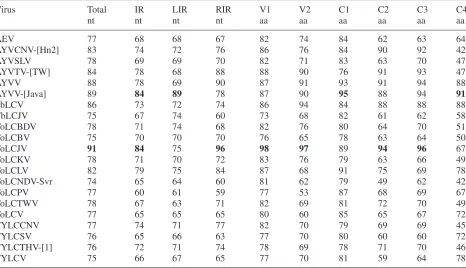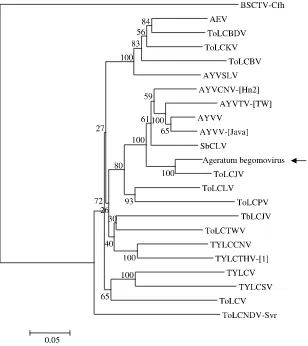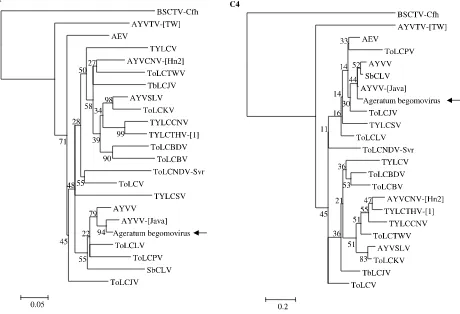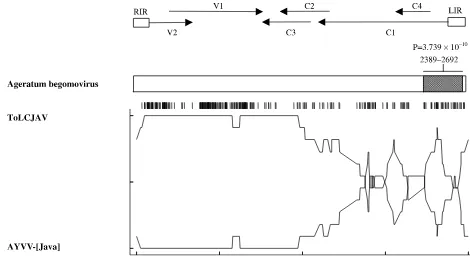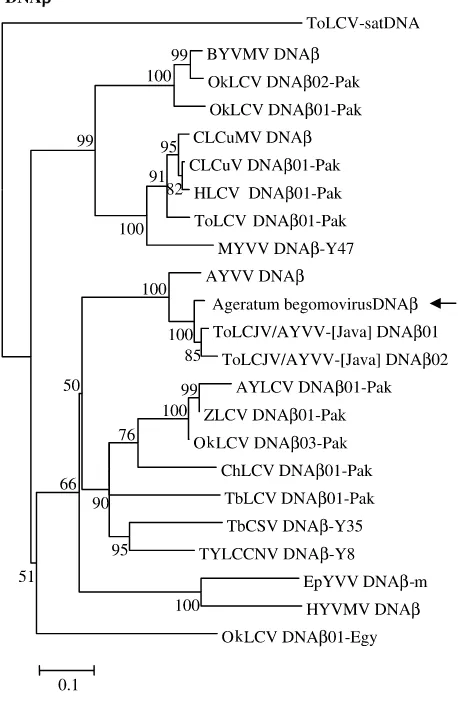DOI 10.1007/s00705-006-0928-3 Printed in the Netherlands
A begomovirus associated with ageratum yellow vein disease
in Indonesia: evidence for natural recombination between tomato
leaf curl Java virus and Ageratum yellow vein virus-[Java]
T. Kon1, K. Kuwabara1, S. H. Hidayat2,andM. Ikegami1
1Department of Life Science, Graduate School of Agricultural Science, Tohoku University, Sendai, Japan 2Department of Plant Pests and Diseases, Faculty of Agriculture, Bogor Agricultural University, Bogor, Indonesia
Received June 7, 2006; accepted December 12, 2006; published online February 12, 2007 #Springer-Verlag 2007
Summary
A begomovirus (2747 nucleotides) and a satellite
DNAb
component (1360 nucleotides) have been
isolated from
Ageratum conyzoides
L. plants with
yellow vein symptoms growing in Java, Indonesia.
The begomovirus is most closely related to Tomato
leaf curl Java virus (ToLCJV) (91 and 98% in the
total nucleotide and coat protein amino acid
se-quences, respectively), although the products of
ORFs C1 and C4 are more closely related to those
of Ageratum yellow vein virus-[Java] (91 and 95%
identity, respectively). For this reason, the
begomo-virus it is considered to be a strain of ToLCJV and
is referred to as ToLCJV-Ageratum. The virus
prob-ably derives from a recombination event in which
nucleotides 2389–2692 of ToLCJV have been
re-placed with the corresponding region of the
AYVV-[Java] genome, which includes the 5
0part of the
intergenic region and the C1 and C4 ORFs.
In-fection of
A. conyzoides
with ToLCJV-Ageratum
alone produced no symptoms, but co-infection with
DNAb
induced yellow vein symptoms. Symptoms
induced in
Nicotiana benthamiana
by
ToLCJV-Ageratum, ToLCJV and AYVV-[Java] are consistent
with the exchange of pathogenicity determinant
ORF C4 during recombination.
Introduction
Geminiviruses have circular single-stranded DNA
genomes with one or two components that are
en-capsidated in geminate particles. Geminiviruses are
currently divided into four genera on the basis of
their genome organization and biological properties
[15]. Most of the geminiviruses are transmitted by
whiteflies and belong to the genus
Begomovirus
.
These species have great economic importance and
enormous diversity resulting from their widespread
geographic distribution and host adaptation [42].
Begomoviruses generally have bipartite genomes
(designated as DNA-A and DNA-B) and infect
Nucleotide sequence data reported are available in theDDBJ=EMBL=GenBank database under the accession numbers AB162141 (ToLCJV-Ageratum) and AB162142 (DNAb03).
dicotyledonous plants. However, some
begomo-viruses do not have a DNA-B component, such as
tomato leaf curl virus (ToLCV) [14], tomato leaf
curl Karnataka virus (ToLCKV) [8], tomato leaf
curl Madagascar virus (ToLCMGV) [12], and
to-mato leaf curl Philippines virus (ToLCPV) [25].
These viruses have been shown to produce typical
disease symptoms when introduced into tomato
using a single genomic component.
The first begomovirus satellite DNA, referred to
as defective DNAb, was identified by Dry et al.
[13]. Many monopartite begomovirus=DNAb
com-plexes have since been identified in a wide variety
of plant species growing throughout the Old World
[2, 4, 22, 26, 36, 37, 43]. DNAb
components have
no significant homology with their helper
begomo-viruses, on which they are dependent for their
repli-cation, encapsidation, and movement within and
between plants [36].
Tomato leaf curl disease is one of the most
dam-aging tomato diseases worldwide and causes
im-portant losses in tomato crop yield [43]. Many
viruses that cause leaf curl disease in tomato have
been characterized [7, 8, 14, 12, 21, 25, 34, 41]. We
have isolated tomato leaf curl Java virus (ToLCJV),
Ageratum yellow vein virus-[Java] (AYVV-[Java]),
and two satellite DNAbs, DNAb01 and DNAb02,
from tomato plants in Java, Indonesia, and reported
the role of these satellite DNAs in the etiology of
begomovirus disease [26].
A. conyzoides
is a
wide-spread weed that frequently exhibits yellow vein
symptoms that have been attributed to
begomovi-rus infection [6, 36]. We have also reported that
A. conyzoides
acts as a reservoir for economically
important viral diseases that infect tomato plants in
Indonesia [26, 41].
In this paper, we describe the identification and
characterization of a begomovirus and a DNAb
iso-lated from
A. conyzoides
plants with yellow vein
disease in Java, Indonesia. The begomovirus has a
chimeric genome that may have arisen from
recom-bination between ToLCJV and AYVV-[Java]. We
propose to call this virus tomato leaf curl Java
virus-Ageratum, and have designated the DNAb
as DNAb03. We also describe the symptoms
induced by ToLCJV-Ageratum and DNAb03 in
A. conyzoides
and
Nicotiana benthamiana
plants.
Materials and methods
Isolation of a viral genomic DNA and a satellite DNA
A. conyzoides plants with yellow vein symptoms were col-lected in Bandung, West Java, Indonesia, in 2004. Total plant DNA was extracted from the leaf tissue of virus-infected
A. conyzoidesplants and subjected to the polymerase chain reaction (PCR) as described by Kon et al. [25].
Using the begomovirus DNA-A-specific primers UPV1 and UPC 2 [5], a 2.7-kbp DNA fragment was isolated from these plants and sequenced. This viral fragment was found to contain a singleBamHI restriction site. Overlapping primers containing a BamHI site were designed to obtain a full-length clone corresponding to the viral genomic DNA-A; the sequences of the primers were 50-GGATCCACTCGTAA ACGAATTCCCAGAGAC-30 (AYBam1) and 50-GGATCC CACATGTTTAAAATAATACTTGG-30 (AYBam2) (BamHI sites underlined). The putative full-length DNA was ampli-fied and cloned into the pGEM-T Easy vector (Promega) to produce the plasmid pAY1 (ageratum begomovirus).
Two methods were used in an attempt to detect a po-tential DNA-B component in virus-infectedA. conyzoides
plants. In the first method, we attempted to amplify a DNA-B genomic component using PCR with the primers DNABLC1=DNABLC2 and DNABLV2 [18]. In the sec-ond method, we performed PCR using the primers CRv1 (50
-TAATATTACCGGATGGCCGC-30
) and CRc2 (50 -AAAAAATTATGCCA-30) to attempt to amplify near-full-length DNA fragments representing the genome com-ponent(s) of begomoviruses with an intergenic (IR)=
common region (CR) sequence similar to that of the ager-atum begomovirus. The resulting PCR-amplified fragment was subjected to restriction analysis as described by Kon et al. [25].
The satellite DNA fragment was amplified from total plant DNA using the primers Beta01=Beta02, which were designed to amplify all DNAbcomponents [3]. The 1.4-kbp PCR product contained a single BglII site. Overlapping primers containing aBglII restriction site (underlined), with the sequences 50-AGATCTGGAAAACGTGAGTGGGCCG AATG-30 (betaBgl1) and 50-AGATCTGTTTTGTGTGTGG GGCC-30 (betaBgl2), were designed in order to amplify a full-length DNAbfragment. The putative full-length DNAb
was amplified and cloned into pGEM-T Easy to produce the plasmid pAYb03 (DNAb).
Sequence analysis
using DNASIS Pro version 2.6 (Hitachi Software Engi-neering). Multiple sequence alignments were created using the optimal alignment method of DNASIS. Phylo-genetic and molecular evolutionary analyses comparing the ageratum begomovirus and DNAb sequences to the sequences of other begomovirus and satellite genomes available in GenBank were generated using the neighbor-joining method in MEGA version 3.0 with 1000 bootstrap repetitions [28].
RDP (recombination detection program) version 2.0 [31] was used to search for recombination events by de-tecting potential recombined sequences, identifying likely parent sequences, and localizing possible recombina-tion break points. The RDP settings used were multiple comparison correction off, internal reference selection, highest acceptable probability 0.0001, and a window size of 10.
Construction of infectious clones and agroinoculation
[image:3.595.306.534.65.222.2]Standard methods were used to construct two infectious clones containing partial repeats in the binary vector pBI121 (Clontech) (Fig. 1): a 1.2mer of the begomovirus
Table 1. Nucleotide and amino acid sequence identities (%) between the ageratum virus and other begomoviruses
Virus Total IR LIR RIR V1 V2 C1 C2 C3 C4
nt nt nt nt aa aa aa aa aa aa
AEV 77 68 68 67 82 74 84 62 63 64
AYVCNV-[Hn2] 83 74 72 76 86 76 84 90 92 42
AYVSLV 78 69 69 70 82 71 83 63 70 47
AYVTV-[TW] 84 78 68 88 88 90 76 91 93 47
AYVV 88 78 69 90 87 91 93 91 94 88
AYVV-[Java] 89 84 89 78 87 90 95 88 94 91
SbLCV 86 73 72 74 86 94 84 88 88 88
TbLCJV 75 67 74 60 73 68 82 61 62 58
ToLCBDV 78 71 74 68 82 76 80 64 70 51
ToLCBV 75 70 70 70 76 65 78 63 64 50
ToLCJV 91 84 75 96 98 97 89 94 96 67
ToLCKV 78 71 70 72 83 76 79 63 66 49
ToLCLV 82 79 75 84 87 68 91 75 69 78
ToLCNDV-Svr 74 65 64 60 81 62 79 49 62 42
ToLCPV 77 60 61 59 77 53 87 68 69 67
ToLCTWV 78 67 63 71 82 69 81 72 70 49
ToLCV 77 65 65 65 80 60 85 65 67 72
TYLCCNV 77 74 71 77 82 70 79 69 69 45
TYLCSV 76 65 66 63 77 70 80 60 60 72
TYLCTHV-[1] 76 72 71 74 78 69 78 71 70 46
TYLCV 75 66 67 65 77 70 81 59 64 78
ntNucleotide,aaamino acid.
[image:3.595.66.532.370.638.2]IR Intergenic region,LIRleft intergenic region,RIRright intergenic region. Highest values are in bold.
Fig. 1. Construction of infectious clones ofAthe ageratum begomovirus andBthe ageratum begomovirus and DNAb. Open circles indicate the stem-loop-forming region. Arrows represent predicted ORFs in both orientations (C, comple-mentary;V, virion-sense). The restriction sites used in the construction are shown: BamHI (nt 136) and EcoRI (nt 2254) in the ageratum begomovirus genomic DNA and
DNA, either alone (pBAY1.2) or together with a 1.6mer of DNAb (pBAY1.2b). TheAgrobacterium tumefaciensstrain C58C1 was transformed with the plasmids using the freeze-thaw method [10].Ageratum conyzoidesandN. benthamiana
seedlings were used for agroinoculation experiments. Agro-inoculation and viral DNA detection were carried out as described by Kon et al. [24].
Results
Ageratum begomovirus and satellite DNA
genome organization
The complete nucleotide sequence of the
agera-tum begomovirus genomic DNA (accession
[image:4.595.62.370.181.527.2]ber AB162141) consists of 2747 nucleotides. The
sequence has the genome organization typical of
whitefly-transmitted monopartite begomoviruses
from the Old World, which have two open reading
frames (ORFs) on the virion-sense strand and four
ORFs on the complementary-sense strand that all
encode predicted proteins of molecular masses
greater than 10 kDa. The two ORFs on the viral
strand are designated V1 (coat protein; CP) and
V2, and the four ORFs on the complementary strand
are designated C1 (replication-associated protein;
Rep), C2 (transcriptional activator protein; TrAP),
C3 (replication enhancer; REn), and C4. A 33-base
region with the potential to form a stem loop (5
0-GCGGCCATCCGTATAATATTACCGATGGCC
GCG-3
0) is present in the intergenic region (IR).
This sequence includes the conserved
nonanucleo-tide TAATATTAC, which contains the DNA nicking
site for the initiation of viral strand replication in the
stem-loop structure. The putative Rep-binding motif
GGAGACA is present in the virion-sense strand
of the ageratum begomovirus genomic DNA, at
nu-cleotides 2615–2621, 2642–2648, and 2649–2655.
Efforts to detect DNA-B components associated
with the ageratum begomovirus using both RFLP
analysis and PCR using the primers DNABLC1=
DNABLC2 and DNABLV2 were unsuccessful.
The ageratum begomovirus DNAb
(accession
number AB162142) is 1360 nucleotides in length.
This DNAb
contains one ORF (bC1) in the
com-plementary-sense strand that encodes a putative
polypeptide of 13.6 kDa (118 amino acids), and an
A-rich region (
65% A) between nucleotides 733
and 946. The putative Rep-binding motif in the
begomovirus genome is not present in the DNAb
component, although the similar sequences GGA
GAAG
(nucleotides
1224–1230),
GGTGTGTA
(nucleotides 1274–1281), and GGTAGAAA
(nucle-Fig. 3. Neighbor-joining phylogenetic tree generated using the deduced amino acid sequences of begomovirusC1andC4
[image:5.595.69.529.335.649.2]otides 1292–1299) are located in the virion-sense
strand upstream of the stem loop.
Sequence analysis
BLAST searches using the entire DNA sequence
revealed that the ageratum begomovirus is most
closely related to monopartite begomoviruses from
Southeast Asia (Table 1). It shares the highest
nu-cleotide sequence identity (91%) and CP amino
acid identity (98%) with ToLCJV. For the V2, C2
and C3 ORF products, the ageratum begomovirus
also exhibits the highest amino acid identity (94–
97%) with counterparts in ToLCJV. However, for
the C1 and C4 ORF products, the ageratum
begom-ovirus shows the highest amino acid identity (95
and 91%, respectively) with counterparts in
AYVV-[Java]. The ageratum begomovirus IR has
nucleo-tide identities of 84% with that of AYVV-[Java] and
84% with that of ToLCJV. It shows the highest
nucleotide identity in the left IR (LIR) with
AYVV-[Java], at 89%, whereas that of the right IR (RIR) is
most similar to that from ToLCJV, at 96%.
A phylogenetic tree was created using the
nucle-otide and amino acid sequences of begomoviruses
from the Old World. A phylogenetic analysis of the
DNA-A component sequences resulted in the
ager-atum begomovirus clustering with ToLCJV (Fig. 2).
A similar relationship appeared in an analysis of
the ageratum begomovirus CP sequence (data not
shown). In contrast, phylogenetic analyses of both
the C1 and C4 amino acid sequences resulted in
the ageratum begomovirus clustering with
AYVV-[Java] (Fig. 3).
[image:6.595.54.524.355.615.2]Using a recombination detection program (RDP),
we examined the possibility that ageratum
begomo-virus has a chimeric genome that arose from a
re-combination event between those of ToLCJV and
AYVV-[Java]. The RDP analysis provided evidence
of recombination between these two viruses. In this
recombination event, a region of the ToLCJV
ge-nome (from nucleotides 2389 to 2692) was replaced
with the corresponding AYVV-[Java] genomic
sequence (RDP P-value
¼
3.739
10
10), which
in-cludes the 5
0portion of the IR, C4 and C1 ORFs
(Fig. 4). ToLCJV was identified as a major parent
of ageratum begomovirus, and AYVV-[Java] was
identified as a minor parent. The ageratum virus
clearly has a backbone of the ToLCJV genome.
According to the International Committee on
Tax-onomy of Viruses (ICTV) criteria for begomovirus
species demarcation using DNA-A nucleotide and
CP amino acid sequences [15], these results
indi-cate that the ageratum begomovirus is a strain of
ToLCJV, for which the name tomato leaf curl Java
virus-Ageratum (ToLCJV-Ageratum) is proposed.
The sequence of the ToLCJV-[Ageratum] DNAb
has the greatest percentage identity (91 and 90%,
[image:7.595.306.535.327.678.2]respectively) with those of DNAb01 and DNAb02
(Kon et al., 2006), which are associated with
ToLCJV and AYVV-[Java], and has a lower
per-centage identity (82%) with that of AYVV DNAb.
The DNAb bC1 product has a high amino acid
iden-tity with its counterparts in ToLCJV and
AYVV-[Java] DNAb01 (94%) and DNAb02 (87%), and a
lower amino acid identity with its counterpart in
AYVV DNAb
(77%). ToLCJV-Ageratum DNAb
has no obvious sequence homology in the
ToLCJV-Ageratum genome, except for the nonanucleotide
TAATATTAC. A phylogenetic tree was constructed
based on an alignment of the complete
ToLCJV-Ageratum DNA nucleotide sequence and those
of selected DNAbs associated with other
mono-partite begomoviruses (Fig. 5). ToLCJV-Ageratum
DNAb
clusters with ToLCJV and AYVV-[Java]
DNAb01 and DNAb02, which were isolated from
2Indonesian tomato plants showing leaf curl
dis-ease. ToLCJV-Ageratum DNAb
also clusters with
AYVV DNAb
but is only distantly related to other
DNAbs. These results show that the relatedness
of the ToLCJV-Ageratum DNAb
with other
simi-lar entities is linked to the geographic origins of
these molecules. Based on these results, we
pro-posed the name ToLCJV-Ageratum DNAb03 for
this DNAb.
Infectivity and symptoms induced by
ToLCJV-Ageratum and DNA
03
The infectivity and symptoms caused by
ToLCJV-Ageratum and DNAb03 in
A. conyzoides
and
N. benthamiana
were examined (Table 2). Plants
mock inoculated with
Agrobacterium
containing
the empty binary vector did not develop
symp-toms (Fig. 6a). When introduced into
A. conyzoides
plants by agroinoculation, ToLCJV-Ageratum alone
(clone pBAY1.2) infected the plants systemically
but caused no symptoms (Fig. 6b). However,
co-inoculation of ToLCJV-Ageratum and DNAb03
(clone pBAY1.2b03) resulted in typical yellow vein
symptoms at 28 days post-inoculation (dpi) (Fig. 6c).
No symptoms were observed on
A. conyzoides
plants
agroinoculated with DNAb03 alone. The presence
of viral genomic DNA and DNAb
in
agroinocu-lated plants was confirmed by Southern blot
analy-sis (data not shown).
[image:8.595.62.534.303.443.2]N. benthamiana
plants agroinoculated with
ToLCJV-Ageratum alone were systemically infected
Table 2. Infectivity of ToLCJV-Ageratum and DNAb03 byAgobacterium-mediated inoculation
Plant Inoculuma Infectivityb Symptoms
Ageratum conyzoides pBI121 0=24 (3) no symptoms
pBAY1.2 5=24 (3) no symptoms
pBAY1.2b 20=24 (3) yellow vein
pBAYb 0=24 (3) no symptoms
Nicotiana benthamiana pBI121 0=15 (3) no symptoms
pBAY1.2 15=15 (3) severe upward leaf curl, vein-swelling and stunting pBAY1.2b 15=15 (3) severe downward leaf curl and stunting
pBAYb 0=24 (3) no symptoms
pBToX1.4 15=15 (3) mild downward leaf curl
pBToB1.4 15=15 (3) severe upward leaf curl, vein-swelling and stunting a pBAY1.2, ToLCJAV-Ageratum; pBAY1.2b, ToLCJAV-AgeratumþDNAb03; pBAYb, DNAb03. Infectious clones of pBToX1.4 (ToLCJV) and pBToB1.4 (AYVV-[Java]) were previously constructed by Kon et al. [26].
b Number of infected plants=number of plants inoculated (number of experiments).
a
b
c
[image:8.595.64.498.498.644.2]and developed severe upward leaf curl,
vein-swell-ing, and stunting symptoms. Agroinoculation of
N. benthamiana
with ToLCJV induced mild
down-ward leaf curl symptoms, whereas AYVV-[Java]
in-duced severe upward leaf curl, vein-swelling, and
stunting symptoms. The symptoms that
ToLCJV-Ageratum caused in
N. benthamiana
were similar
to those caused by AYVV-[Java] but differed from
those caused by ToLCJV.
N. benthamiana
plants
co-agroinoculated
with
ToLCJV-Ageratum
and
DNAb03 developed severe downward leaf curl and
stunting symptoms.
Discussion
We have detected a new recombinant begomovirus
that infects
A. conyzoides
plants in Indonesia and is
accompanied by a satellite DNAb. We isolated and
sequenced the full-length genomes of both agents.
Phylogenetic and genetic recombination analyses
demonstrated that the weed-infecting begomovirus
is a monopartite begomovirus typical of the eastern
hemisphere and has a high identity to ToLCJV,
except for the region corresponding to the C1 and
C4 ORFs and the origin of replication, which show
a higher sequence identity with the AYVV-[Java]
genome. Comparison of the nucleotide and amino
acid sequences with those of other begomoviruses
revealed that the ageratum begomovirus is a strain
of ToLCJV, for which we propose the name tomato
leaf curl Java virus-Ageratum (ToLCJV-Ageratum).
The satellite DNAb, isolated from
A. conyzoides
infected with ToLCJV-Ageratum has high sequence
identity to DNAbs from tomato plants, previously
characterized by Kon et al. [26].
Agroinoculation experiments with
ToLCJV-Ageratum alone demonstrated that the virus can
replicate autonomously and move systemically in
A. conyzoides
plants but does not induce
yel-low vein symptoms. However, in the presence of
DNAb03, ToLCJV-Ageratum does induce these
symptoms, which appear similar to those observed
in the field in Java, Indonesia. Therefore, the
ag-eratum yellow vein disease complex comprises
ToLCJV-Ageratum and DNAb03. The requirement
that both a begomovirus and its associated satellite
DNAb
be present for typical disease symptoms to
occur has been demonstrated for cotton leaf curl,
Bhendi yellow mosaic, ageratum yellow vein, tomato
leaf curl, and tomato yellow leaf curl diseases [4, 22,
26, 36, 43]. DNAb
molecules encode a highly
con-served ORF,
bC1, and are essential for symptom
induction [11, 38]. We demonstrated that DNAb03
is replicated by ToLCJV-Ageratum. A putative
Rep-binding motif (termed iteron [9, 19, 29]), present in
several instances in the ToLCJV-Ageratum genome
is not present in DNAb03, but the DNAb03
se-quence contains a putative iteron sese-quence located
upstream of the stem-loop structure that is identical
to the iteron sequence of DNAb02. However, the
mechanism of Rep-mediated replication of DNAb
has not yet been resolved. The DNAb03 sequences
does not contain the iterons of the ToLCJV-Ageratum
genome, suggesting a more relaxed specificity for
Rep binding during begomovirus replication. The
satellite DNAb
appears to be capable of being
repli-cated by Reps from diverse monopartite and bipartite
begomoviruses [1, 2, 35, 39].
be responsible for this leaf curl phenotype for
gemi-niviruses such as beet curly top virus and tomato
leaf curl virus [27, 40].
The generation of genetic diversity in viral
pop-ulations facilitates adaptation to new hosts and
changing environmental conditions. Three major
forces drive the evolution of viruses: mutation,
re-combination, and reassortment [20]. It is generally
accepted that recombination plays an important
role in the evolution and genetic diversification of
emerging begomovirus populations [16, 17, 23, 32].
We have previously demonstrated that tomato leaf
curl disease is caused by either the ToLCJV=
DNAb02 or the AYVV-[Java]=DNAb02 complexes
[26]. In the present study, we found evidence for
interspecies recombination between ToLCJV and
AYVV-[Java]. Because these viruses have common
hosts, such as tomato and
A. conyzoides
, mixed
infection can occur and viruses may replicate
si-multaneously in the same cell, a prerequisite for
recombination [33]. These results emphasize the
potential for the emergence of novel begomoviruses
by interspecies genetic recombination.
Acknowledgments
This work was partly supported by Grants-in-Aid for Academic Frontier Cooperative Research Project of the Ministry of Education, Culture, Sports, Science and Technol-ogy of Japan.
References
1. Alberter B, Rezaian AM, Jeske H (2005) Replicative intermediates of ToLCV and its satellite DNAs. Virology 331: 441–448
2. Briddon RW, Bull SE, Amin I, Idris AM, Mansoor S, Bedford ID, Dhawan P, Rishi N, Siwatch SS, Abedel-Salam AM, Brown JK, Zafar Y, Markham PG (2003) Diversity of DNAb, a satellite molecule associated with some monopartite begomoviruses. Virology 312: 106–121
3. Briddon RW, Bull SE, Mansoor S, Amin I, Markham PG (2002) Universal primers for the PCR-mediated ampli-fication of DNAb. Mol Biotech 20: 315–318
4. Briddon RW, Mansoor S, Bedford ID, Pinner MS, Saunders K, Stanley J, Zafar Y, Malik KA, Markham PG (2001) Identification of DNA components required for induction of cotton leaf curl disease. Virology 285: 234–243
5. Briddon RW, Markham PG (1994) Universal primers for the PCR amplification of dicot-infecting geminiviruses. Mol Biotech 1: 202–205
6. Bull SE, Tsai WS, Briddon RW, Markham PG, Stanley J, Green SK (2004) Diversity of begomovirus DNAb
satellites of non-malvaceous plants in east and south east Asia. Arch Virol 149: 1193–1200
7. Chakraborty S, Pandey PK, Banerjee MK, Kalloo G, Fauquet CM (2003)Tomato leaf curl Gujarat virus, a newBegomovirusspecies causing a severe leaf curl dis-ease of tomato in Varansi, India. Phytopathology 93: 1485–1495
8. Chatchawankanphanich O, Maxwell DP (2002)Tomato leaf curl Karnataka virus from Bangalore, India, ap-pears to be a recombinant begomovirus. Phytopathology 92: 637–645
9. Chatterji A, Chatterji U, Beachy RN, Fauquet CM (2000) Sequence parameters that determine specificity of binding of the replication-associated protein to its cognate site in two strains ofTomato leaf curl virus-New Delhi. Virology 273: 341–350
10. Chen H, Nelson RS, Sherwood JL (1994) Enhanced recovery of transformants of Agrobacterium tumefa-ciensafter freeze-thaw transformation and drug selec-tion. Biotechniques 16: 664–670
11. Cui X, Tao X, Xie Y, Fauquet CM, Zhou X (2004) A DNAbassociated withTomato yellow leaf curl China virus is required for symptom induction. J Virol 78: 13966–13974
12. Delatte H, Martin DP, Naze F, Goldbach R, Reynaud B, Peterschmitt M, Lett JM (2005) South West Indian Ocean islands tomato begomovirus populations repre-sent a new major monopartite begomovirus group. J Gen Virol 86: 1533–1542
13. Dry IB, Krake LR, Rigden JE, Rezaian MA (1997) A novel subviral agent associated with a geminivirus: the first report of a DNA satellite. Proc Natl Acad Sci USA 94: 7088–7093
14. Dry IB, Rigden JE, Krake LR, Mullineaux PM, Rezaian MA (1993) Nucleotide sequence and genome organi-zation of tomato leaf curl geminivirus. J Gen Virol 74: 147–151
15. Fauquet CM, Stanley J (2005) Revising the way we conceive and name viruses below the species level: a review of geminivirus taxonomy calls for new standard-ized isolate descriptors. Arch Virol 150: 2151–2179 16. Fondong VN, Pita JS, Rey MEC, De Kochko A,
Beachy RN, Fauquet CM (2000) Evidence of synergism between African cassava mosaic virus and a new double-recombinant geminivirus infecting cassava in Cameroon. J Gen Virol 81: 287–297
DNA-B to infectNicotiana benthamianasystemically. J Gen Virol 84: 715–726
18. Green SK, Tsai WS, Shih SL, Black LL, Rezaian A, Rashid MH, Roff MMN, Myint YY, Hong LTA (2001) Molecular characterization of begomoviruses associ-ated with leafcurl diseases of tomato in Bangladesh, Laos, Malaysia, Myanmar, and Vietnam. Plant Dis 85: 1286
19. Hanley-Bowdoin L, Settlage SB, Orozco BM, Nagar S, Robertson D (2000) Geminivirus: models for plant DNA replication, transcription, and cell cycle regula-tion. Crit Rev Biochem Mol Biol 35: 105–140 20. Harrison BD, Robinson DJ (1999) Natural genomic
and antigenic variation in whitefly-transmitted gemini-viruses (begomogemini-viruses). Annu Rev Phytopathol 37: 369–398
21. Hong YG, Harrison BD (1995) Nucleotide sequences from tomato leaf curl viruses from different countries: evidence for three geographically separate branches in evolution of the coat protein of whitefly-transmitted geminiviruses. J Gen Virol 76: 2043–2049
22. Jose J, Usha R (2003) Bhendi yellow vein mosaic disease in India is caused by association of a DNAb
satellite with a Begomovirus. Virology 305: 310–317 23. Kitamura K, Murayama A, Ikegami M (2004) Evidence
for recombination among isolates ofTobacco leaf curl Japan virusandHoneysuckle yellow vein mosaic virus. Arch Virol 149: 1221–1229
24. Kon T, Dolores LM, Bajet NB, Hase S, Takahashi H, Ikegami M (2003) Molecular Characterization of a strain of Squash leaf curl China virus from the Philippines. J Phytopathol 151: 535–539
25. Kon T, Dolores LM, Murayama A, Bajet NB, Hase S, Takahashi H, Ikegami M (2002) Genome organi-zation of an infectious clone ofTomato leaf curl virus
(Philippines), a new monopartiteBegomovirus. J Phyto-pathol 150: 587–591
26. Kon T, Hidayat SH, Hase S, Takahashi H, Ikegami M (2006) The natural occurrence of two distinct begomo-viruses associated with DNAband a recombinant DNA in a tomato plant from Indonesia. Phytopathology 96: 517–525
27. Krake LR, Rezaian MA, Dry IB (1998) Expression of the tomato leaf curl geminivirus C4 gene produces viruslike symptoms in transgenic plants. Mol Plant Microbe Interact 11: 413–417
28. Kumar S, Tamura K, Nei M (2004) MEGA3: integrat-ed software for molecular evolutionary genetics anal-ysis and sequence alignment. Brief Bioinform 5: 150–163
29. Lin B, Akbar Behjatnia SA, Dry IB, Randles JW, Rezaian MA (2003) High-affinity Rep-binding is not required for the replication of a geminivirus DNA and its satellite. Virology 305: 353–363
30. Mansoor S, Briddon RW, Zafar Y, Stanley J (2003) Geminivirus disease complexes: an emerging threat. Trends Plant Sci 8: 128–134
31. Martin DP, Williamson C, Posada D (2005) RDP2: recombination detection and analysis from sequence alignments. Bioinformatics 21: 260–262
32. Monci F, Sanchez-Campos S, Navas-Castillo J, Moriones E (2002) A natural recombinant between the geminivirusesTomato yellow leaf curl Sardinia virus
and Tomato yellow leaf curl virus exhibits a novel pathogenic phenotype and is becoming prevalent in Spanish populations. Virology 303: 317–326
33. Morilla G, Krenz B, Jeske H, Bejarano ER, Wege C (2004) Tete a tete of Tomato yellow leaf curl virus and Tomato yellow leaf curl Sardinia virus in single nuclei. J Virol 78: 10715–10723
34. Padidam M, Beachy RN, Fauquet CM (1995) Tomato leaf curl geminivirus from India has a bipartite genome and coat protein is not essential for infectivity. J Gen Virol 76: 25–35
35. Saeed M, Behjatnia SA, Mansoor S, Zafar Y, Hasnain S, Rezaian MA (2005) A single complementary-sense transcript of a geminiviral DNAbsatellite is determinant of pathogenicity. Mol Plant Microbe Interact 18: 7–14 36. Saunders K, Bedford ID, Briddon RW, Markham PG, Wong SM, Stanley J (2000) A unique virus complex causesAgeratumyellow vein disease. Proc Natl Acad Sci USA 97: 6890–6895
37. Saunders K, Bedford ID, Yahara T, Stanley J (2003) The earliest recorded plant virus disease. Nature 422: 831 38. Saunders K, Norman A, Gucciardo S, Stanley J (2004)
The DNAb satellite component associated with ager-atum yellow vein disease encodes an essential patho-genicity protein (bC1). Virology 324: 37–47
39. Saunders K, Salim N, Mali VR, Malathi VG, Briddon R, Markham PG, Stanley J (2002) Characterisation of Sri Lankan cassava mosaic virus and Indian cassava mosaic virus: evidence for acquisition of a DNA B component by a monopartite begomovirus. Virology 293: 63–74 40. Stanley J, Latham JR (1992) A symptom variant of beet
curly top geminivirus produced by mutation of open reading frame C4. Virology 190: 506–509
41. Sukamto, Kon T, Hidayat SH, Ito K, Hase S, Takahashi H, Ikegami M (2005) Begomoviruses as-sociated with leaf curl disease of tomato in Java, Indonesia. J Phytopathol 153: 562–566
42. Varma A, Malathi VG (2003) Emerging geminivirus problems: a serious threat to crop production. Ann Appl Biol 142: 145–164
